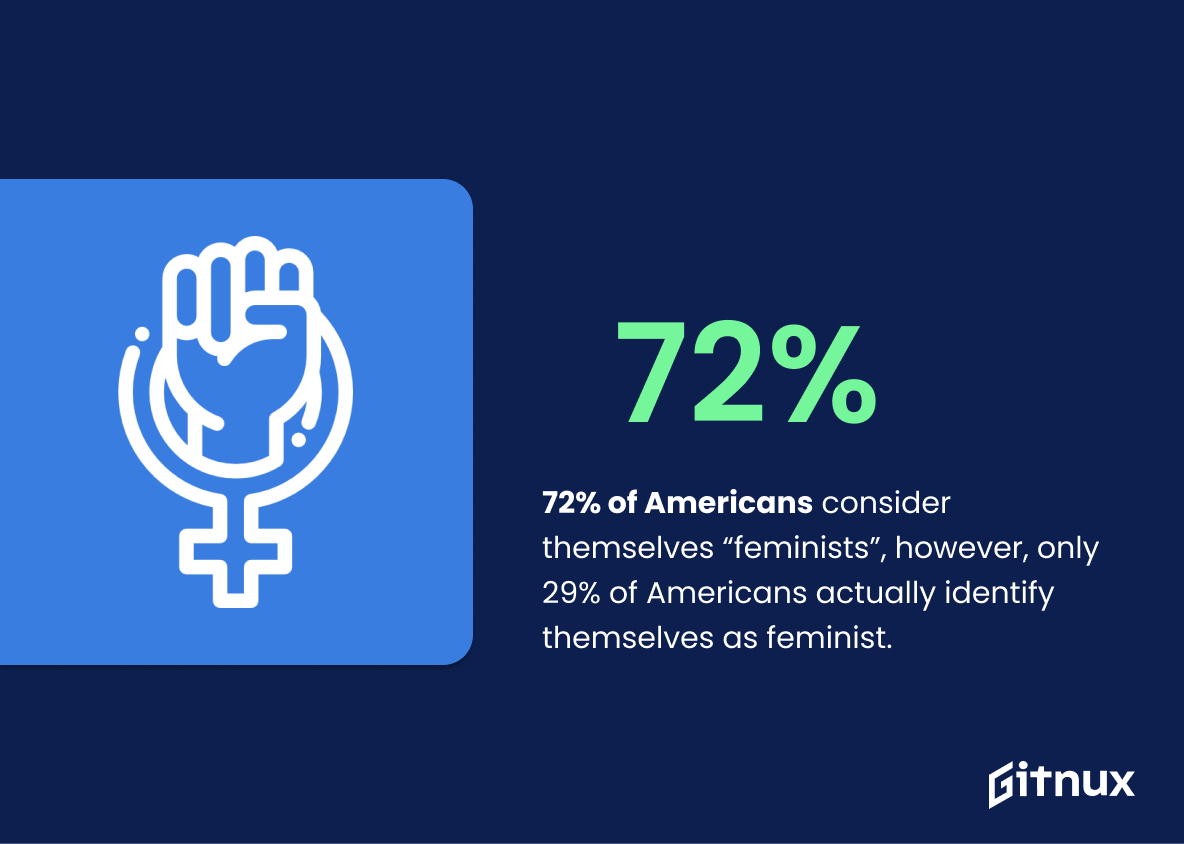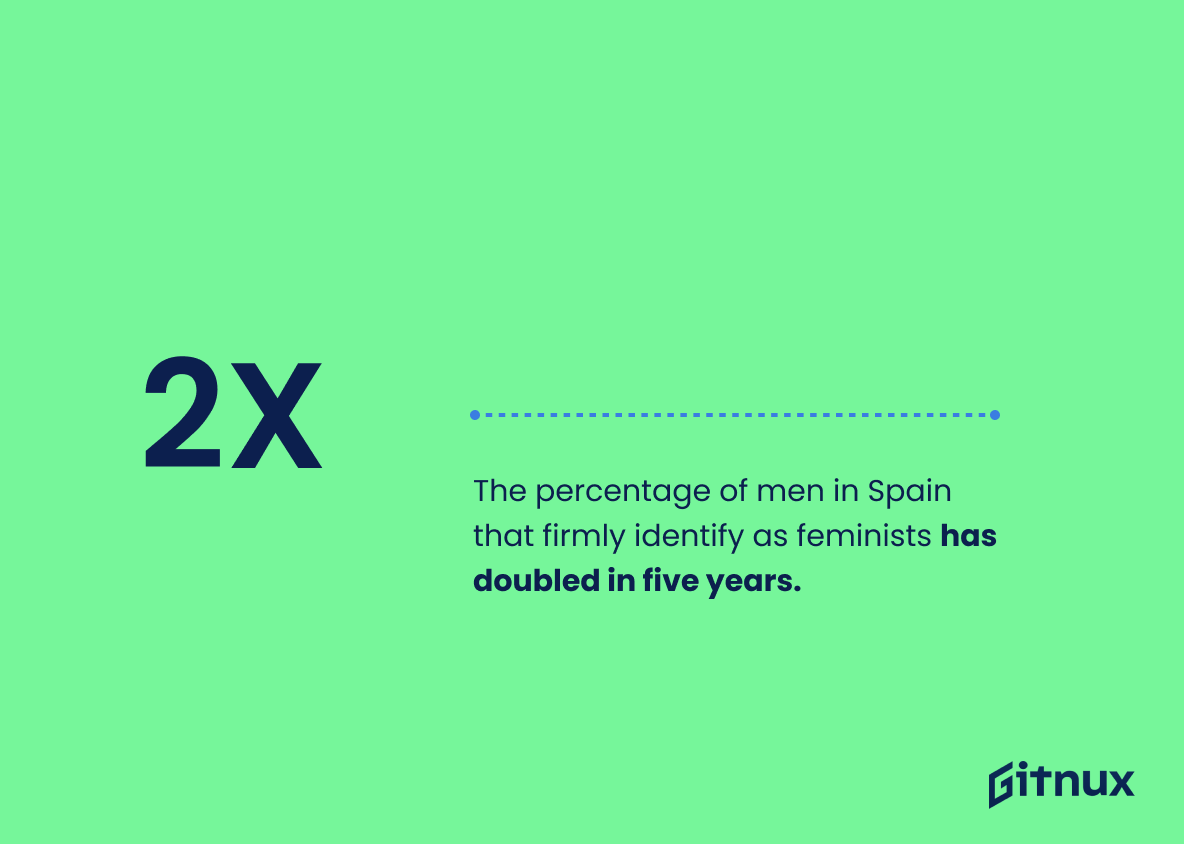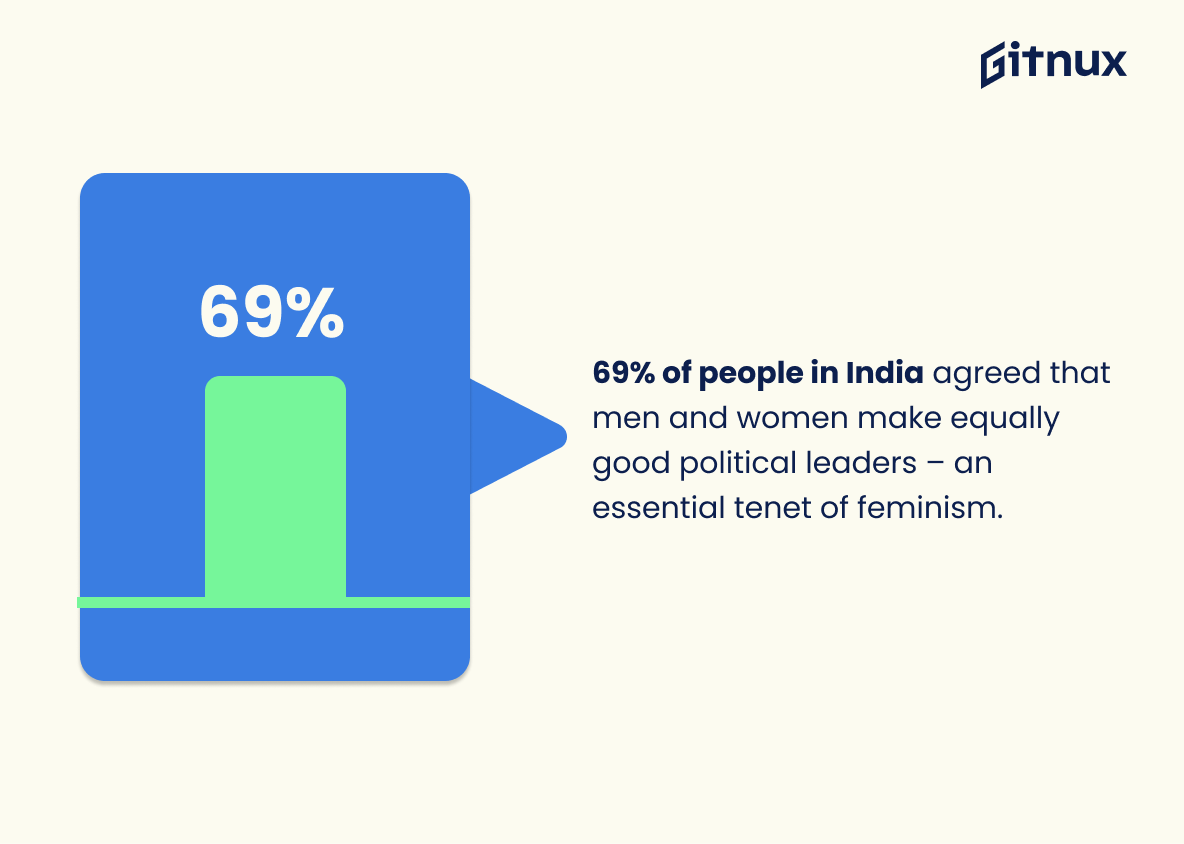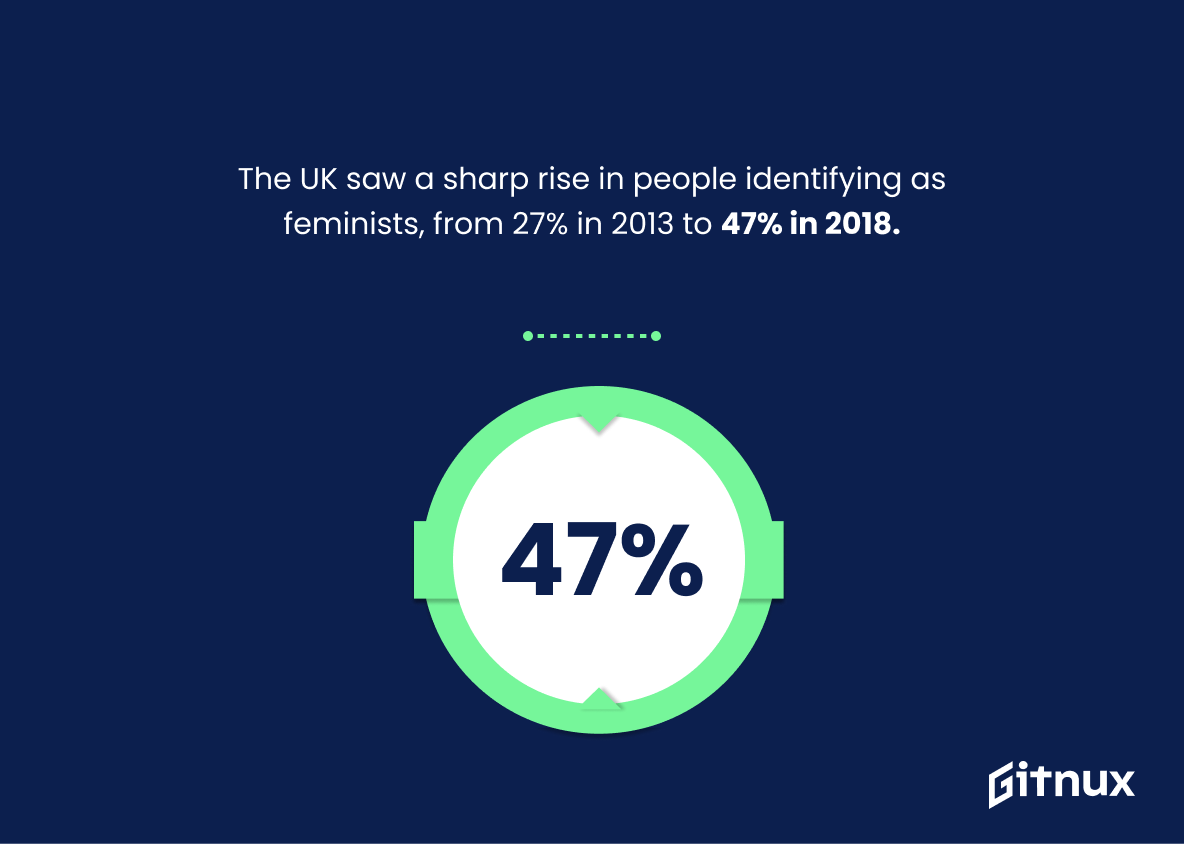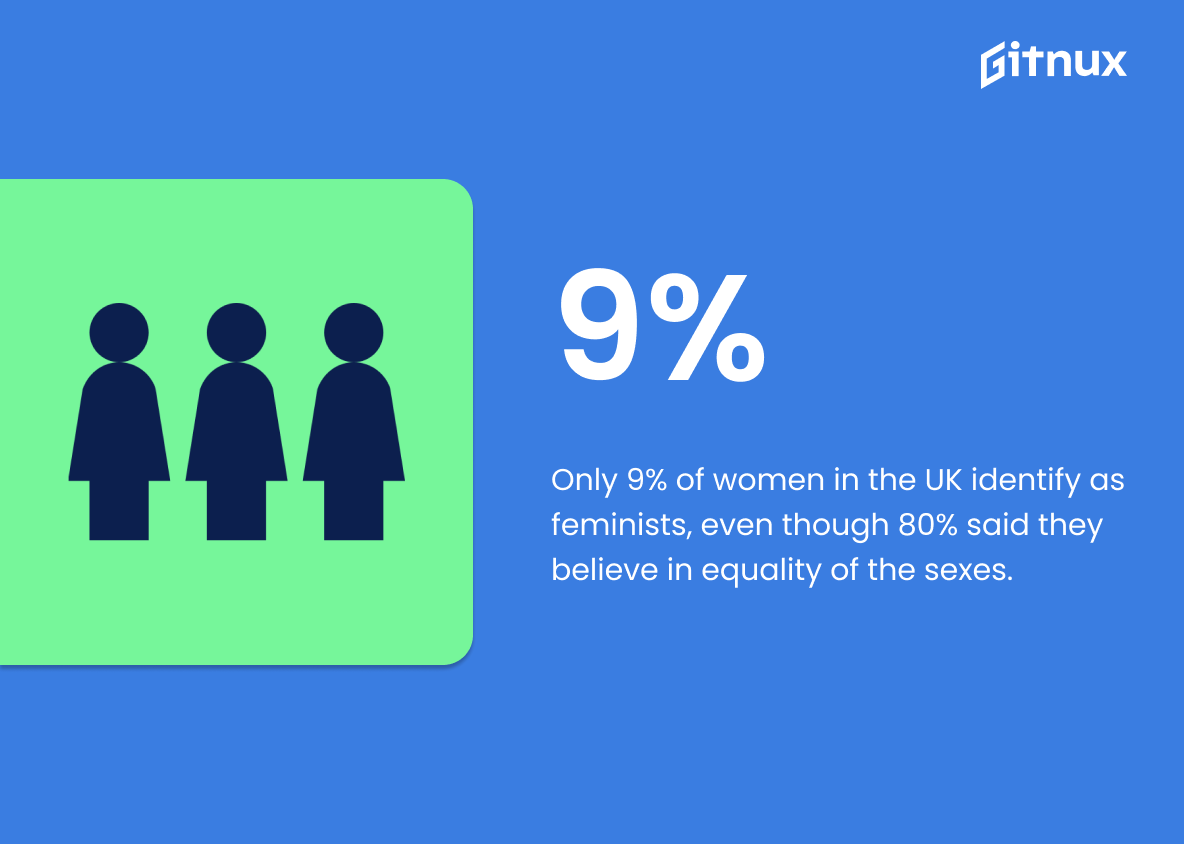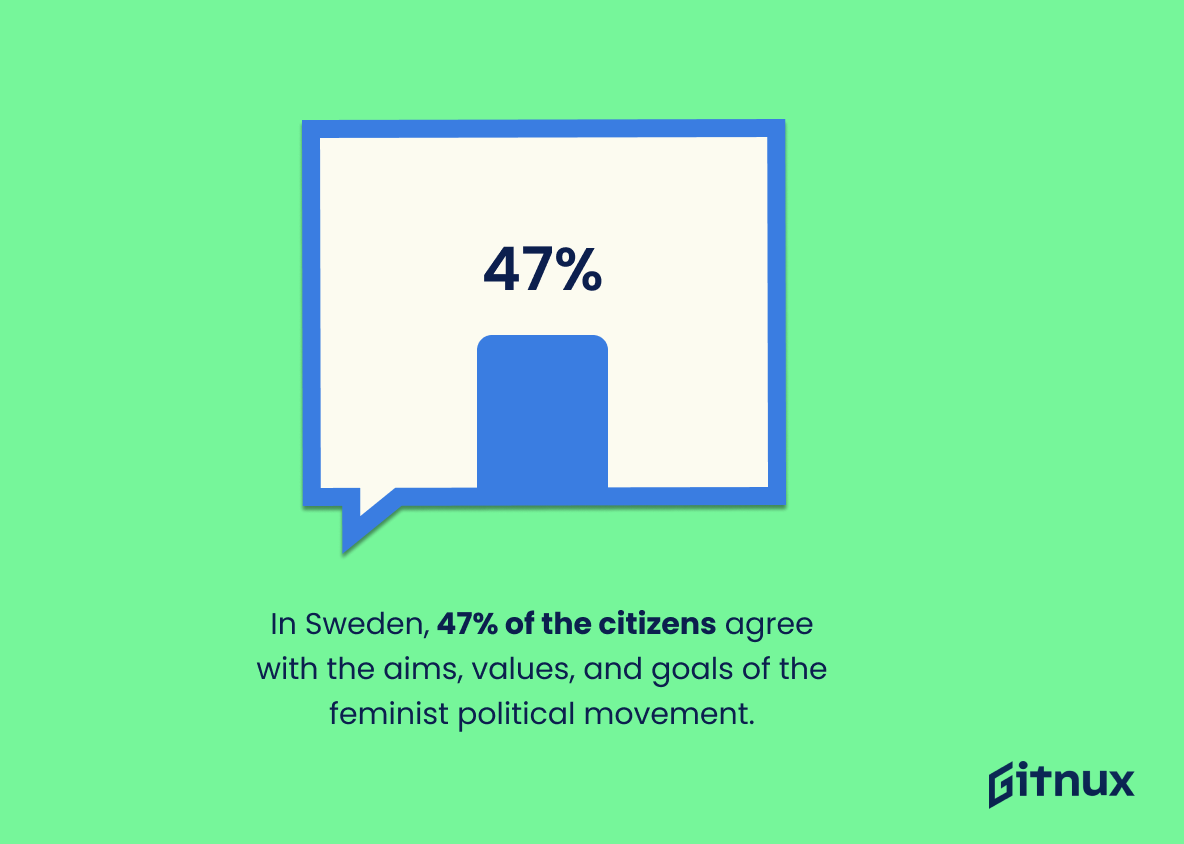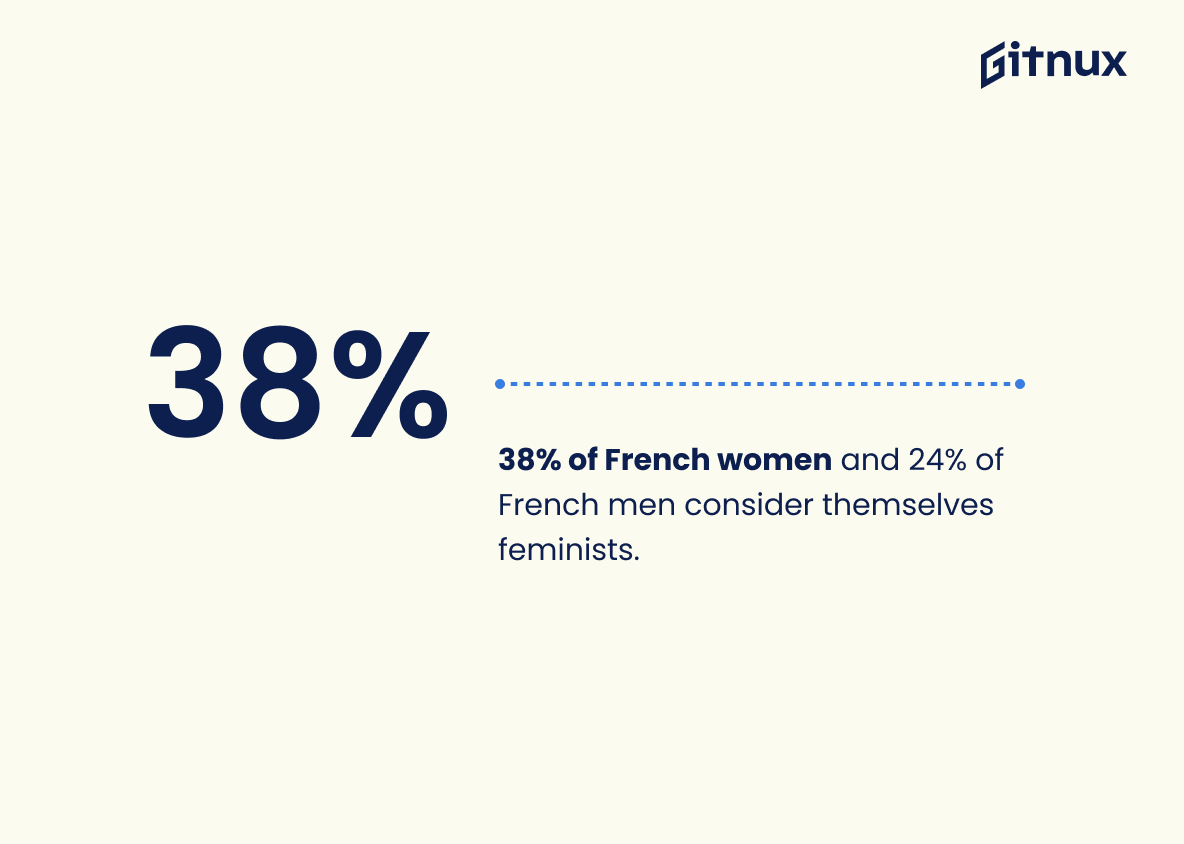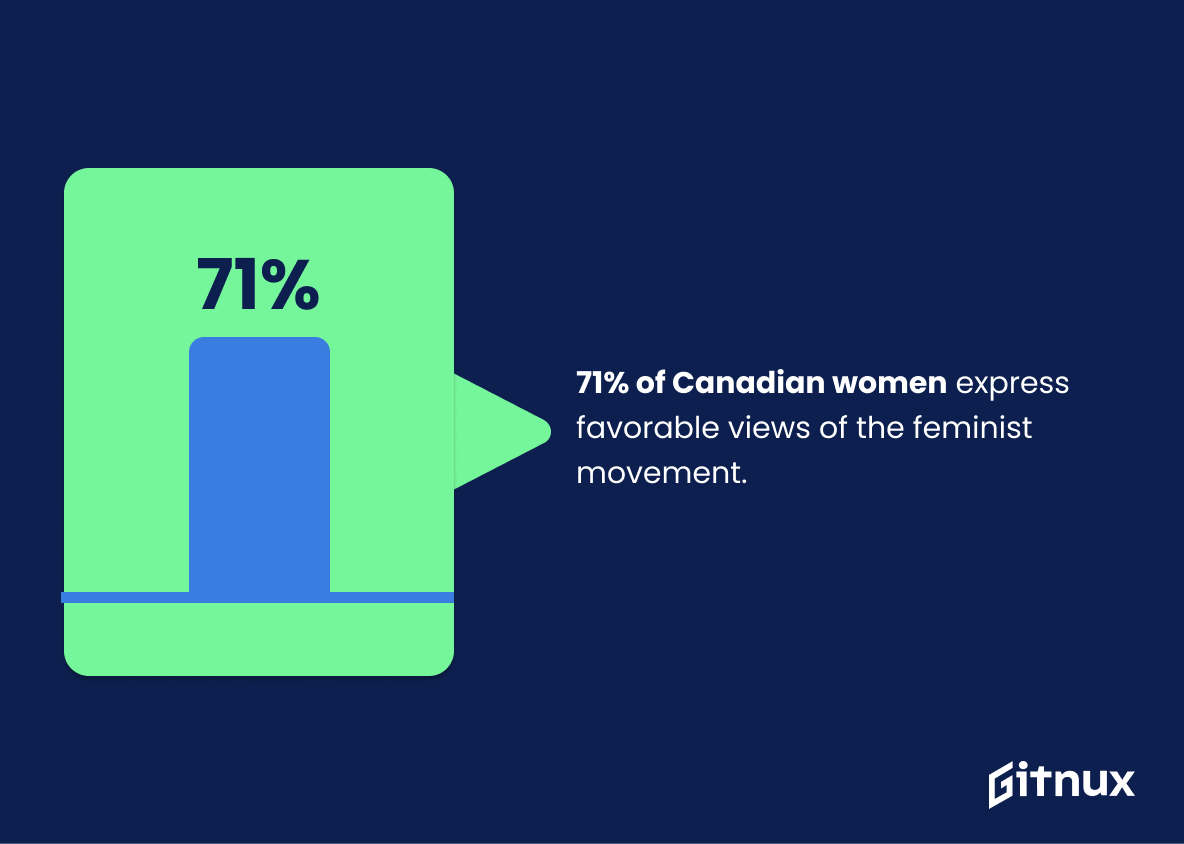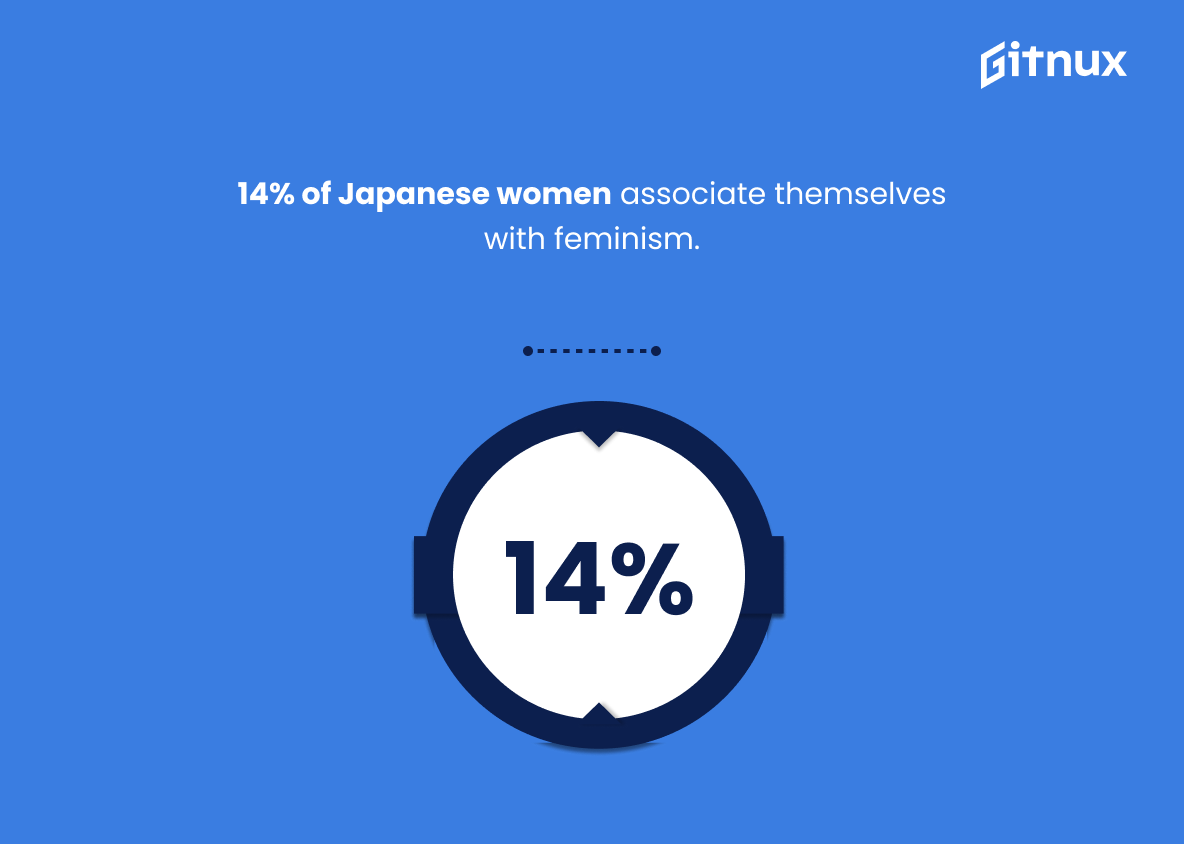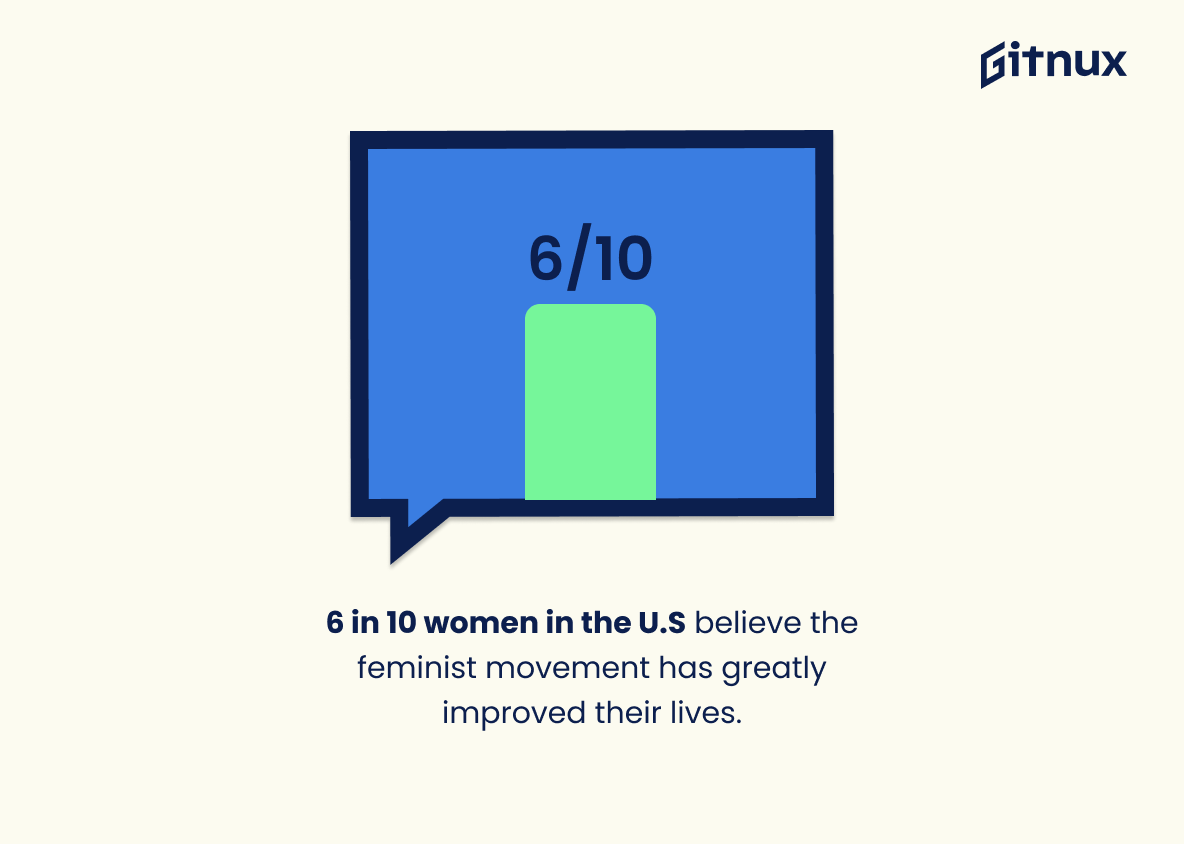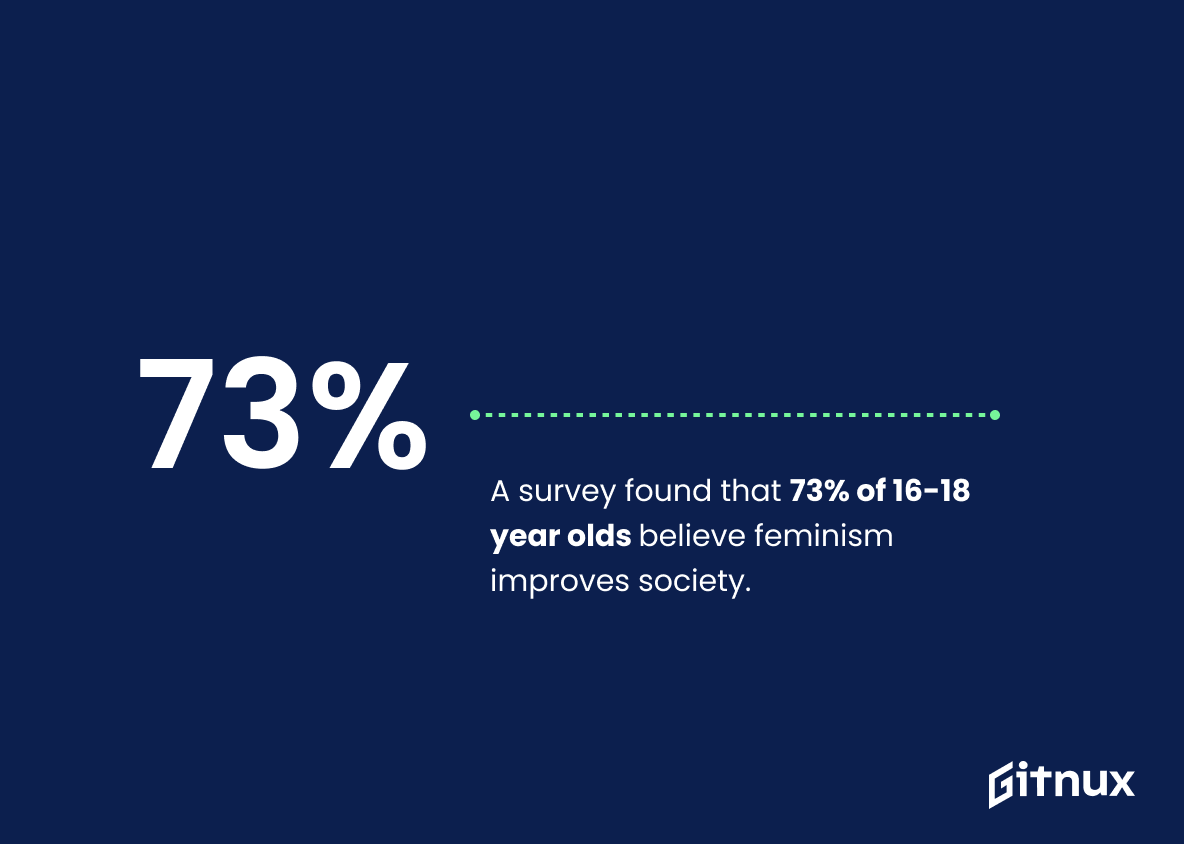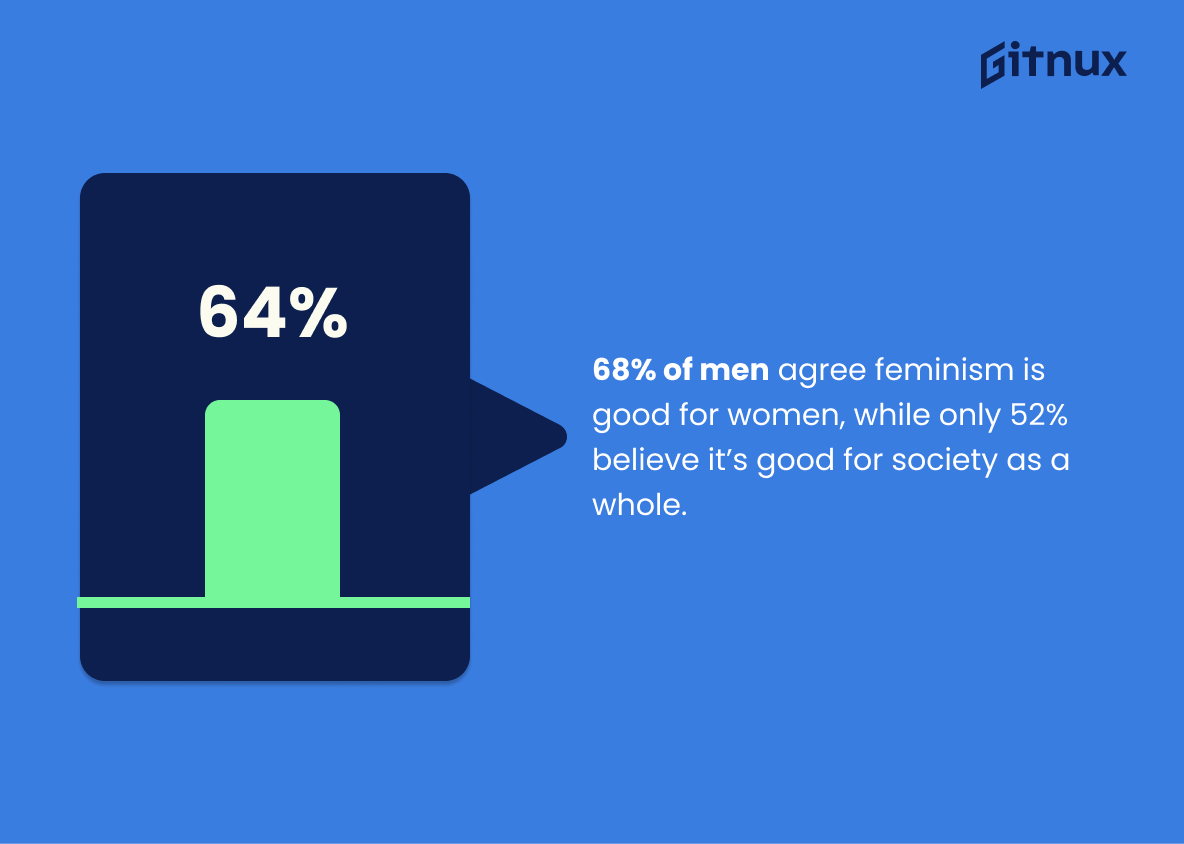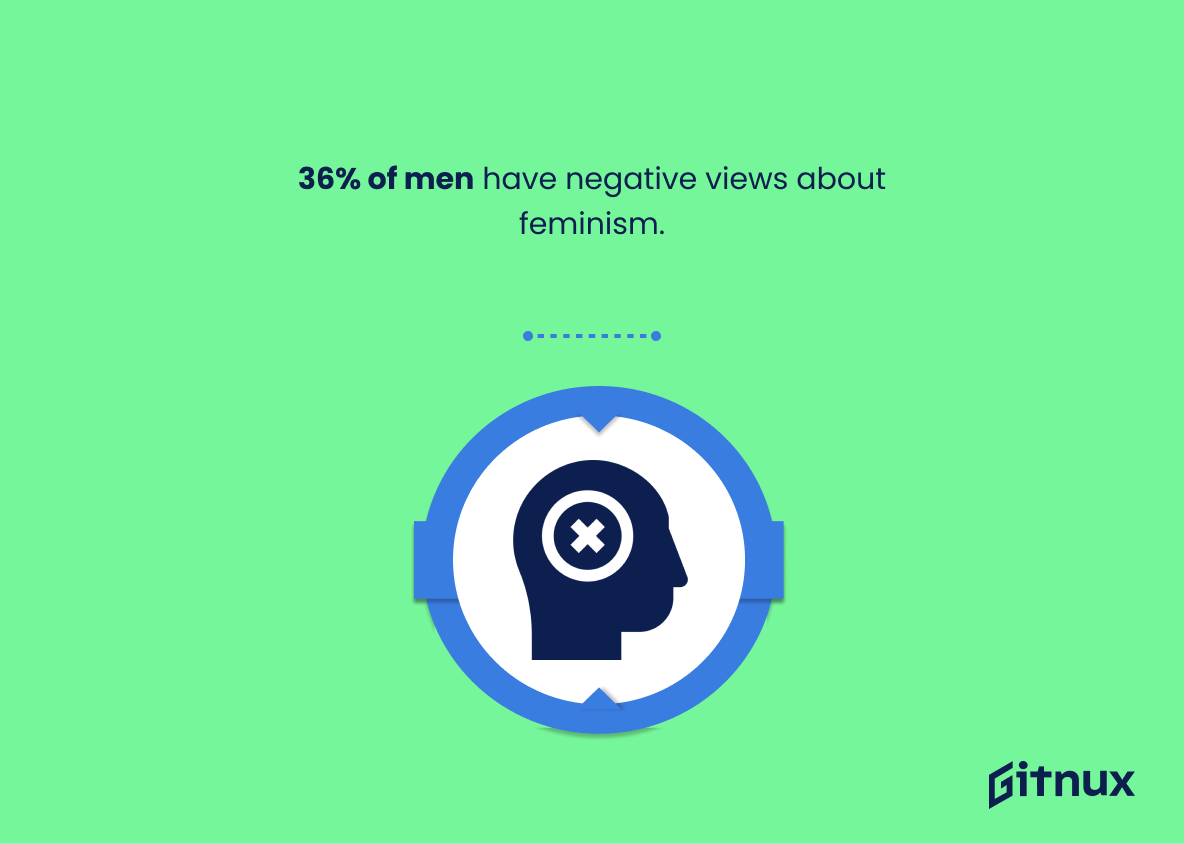Immersed in a world that’s constantly evolving, understanding Feminism has never been more vital. Amid the rapid changes and leaps towards equality, Feminism Statistics provide crucial insight into our progress thus far. As we delve into the profound world of these illuminating numbers, we navigate a gendered map that reflects the diverse realities of millions.
This blog post will guide you through numerous Feminism Statistics, uncovering data that depicts the changing landscapes of gender rights, societal norms, and the fight for equality. Strap in, as we venture to decode the patterns, understanding the strengths of feminist movements, and the areas that still need a robust push.
The Latest Feminism Statistics Unveiled
72% of Americans consider themselves “feminists”, however, only 29% of Americans actually identify themselves as feminist.
Navigating the labyrinth of feminism statistics, this particular one stands as a beacon of intriguing complexity. Highlighting a stark disparity between those who uphold feminist ideals and those who consciously identify as feminists, it poses tantalizing food for thought.
This statistic breathes life into the paradoxical nature of feminism in contemporary American society, embodies the seeming disconnect in public perception, and underscores the potential impact of stereotypes on self-identification. In essence, it propels thought-provoking discourse and paves the way for further exploration, thus adding an enriching layer to the analysis and understanding of feminism statistics in your blog post.
In 2018, 61% of the women in the U.S say they would describe themselves as a feminist.
Reflecting on the pulse of societal perspectives, the 2018 data unfurls an intriguing narrative: a whopping 61% of women in the U.S identified themselves as feminists. Such a hefty percentage maneuvers into focus the deepening roots of feminism, illustrating the paradigm shift in how feminism is perceived and valued in society. Amid discussions on Feminism Statistics, this statistic serves as a striking testament to the mounting acceptance, urge for equality, and the reframing power structures.
It underscores the drive towards embracing feminism, thus helping chart out the evolution and dynamics of this movement in contemporaneous times. This % also prompts insightful discussions about the changing trends, challenges, opportunities, and path course for the feminist movement within the U.S. context.
The percentage of men in Spain that firmly identify as feminists has doubled in five years.
Illuminating the minds of readers with an intriguing revelation like ‘The percentage of men in Spain that firmly identify as feminists has doubled in five years’ throws a spotlight on the journey of gender equality from a fresh perspective. It’s a powerful metric that acts as a testament to how changing mindsets are impacting the feminist movement in Spain.
This potent pointer not only punctuates the narrative on Feminism Statistics but also paints a compelling picture of how male involvement is playing a critical role in escalating the feminism movement. Stepping away from mere numbers and percentages, it kindles thought-provoking discussions around societal transformation, male allyship, and the shifting paradigm of feminism across a diverse cultural landscape such as Spain’s.
69% of people in India agreed that men and women make equally good political leaders – an essential tenet of feminism.
As we unpack the storyline of Feminism Statistics in the blog post, it’s captivating to note the powerful narrative that emerges from India. Picture this, a whooping 69% of the populace radiates a consensus that men and women bear equal prowess as political leaders, a striking testament to fundamental feminism principles. This streak of enlightenment transcends the boundaries of gender stereotypes in politics, revealing an India that champions for equality in leadership.
It’s as though we are peering into an intriguing canvass of a society where feminism isn’t just an abstract or radical ideal, but a fabric of their political realities. This indeed is an indelible indicator of progressiveness and sets an impactful precedent for other societies to emulate.
The UK saw a sharp rise in people identifying as feminists, from 27% in 2013 to 47% in 2018.
Reflecting upon the quoted statistic that illustrates the augmented identification as feminists in the UK, from 27% in 2013 to a significant 47% in 2018, paints an intriguing landscape for the discourse on Feminism Statistics. This reveals a shifting consciousness, an evolution in perception on feminism, unprecedented in its velocity.
Bearing witness to such a considerable growth in a mere half-decade, should invite readers to dig deeper into the roots of this transformation. Did in-depth education on gender equality resonate with the populace, thus pushing ideological change? Alternatively, could it be due to the ripple effects of global feminist movements that made waves during this period?
Furthermore, surveying this dramatic change can fuel discussions around the impact such a shift might have socially, politically, economically, and culturally. Does a higher representation of those identifying as feminists prompt more equitable legislation? Are workplaces becoming more balanced and less discriminatory?
Finally, it nudges us to extrapolate what the next five years might bring. If the trend continues, we might be on the cusp of even more intense societal transformations. As such, this statistic stands as a beacon, guiding us through past dynamics, current trends, and future projections in the fascinating world of Feminism Statistics.
Only 9% of women in the UK identify as feminists, even though 80% said they believe in equality of the sexes.
Emerging from the heart of these figures is a paradox that commands our attention. It unveils the contrast between the small fraction of UK women who openly align themselves with feminism (just 9%) and the vast majority (80%) who stand for gender equality. This tells a fascinating tale: a significant disconnect appears to exist between feminism as a concept and its public understanding or perception.
Profiling feminism within the larger narrative of gender equality, these numbers may unearth underlying prejudices or misunderstandings that align the term feminism with negative connotations, hence dissuading some women from identifying as feminists. Additionally, the numbers might point towards an awareness gap about what feminism truly embodies, hinting at the need to educate and reshape societal understanding about it.
In the realm of our discussion on Feminism Statistics, these numbers provide a critical exploratory avenue. They invite us to decipher the underlying causes, navigate through unspoken narratives, and encourage women to realize that standing for gender equality is the pulse of feminism, making way for broader acceptance and acknowledgment of the movement.
In Sweden, 47% of the citizens agree with the aims, values, and goals of the feminist political movement.
The statistic—that 47% of Swedes align their perspectives with the values, aims, and goals of the feminist political movement—serves as a compass guiding us through the labyrinth of gender perspectives in this Northern European nation. Just like a flickering lighthouse amidst the haze, it sheds light on the socio-political currents that shape the lives of almost half of Sweden’s citizenry.
For a blog post diving into the waters of feminism statistics, this information serves as a robust anchor, underlining the wide-reaching acceptance of feminism in Sweden. Thus, it enables the readers to fathom the depth of feminism’s roots in the Swedish societal landscape and allows for meaningful comparisons with other regions of the world.
38% of French women and 24% of French men consider themselves feminists.
Delving into the heart of feminism statistics, the aforementioned figures offer a crux of insight. Through revealing a 14% discrepancy between French men and women who identify as feminists, it clearly establishes an intriguing gendered perspective in the national feminist discourse. Moreover, these delineate an interesting fabric of societal attitudes towards feminism, giving both readers and analysts ample food for thought.
In the landscape of feminism, these numbers are not just numbers, they become powerful voices and silent narratives echoing from France. Little wonder, then, that they find a paramount place in any discussion on feminism statistics. Simply put, they cleverly weave a complex pattern of understandings, discussions, biases and acceptance revolving around feminism.
71% of Canadian women express favorable views of the feminist movement.
Highlighting that a significant majority of Canadian women – a whopping 71% – voice positive perceptions of the feminist movement, offers a compelling insight into the pervasiveness and relevance of feminism within modern Canadian society. This figure implies that the spirit and principles of feminism have struck a chord with a significant chunk of the female population, thereby underscoring its importance in fighting for gender equality and female empowerment.
Incorporating this statistic in a blog post about Feminism Statistics, then, helps infuse the narrative with the weight and strength of empirical data, illuminating the significant embrace of feminist ideologies within contemporary Canada.
14% of Japanese women associate themselves with feminism.
“Unveiling a layer of intricate globality, the marker revealing that only 14% of Japanese women align with feminism forms a striking piece in our puzzle of understanding Feminism Statistics. It invites a fascinating exploration into the socio-cultural narratives, gender dynamics and perception of feminism within the uniquely poised society of Japan.
Furthermore, it underlines the scope for expanding the conversation of feminism and women empowerment within the Japanese context, and offers a distinct comparison point for global feminist movements. Essentially, it deepens the depth and broadens the breadth of discernment within the blog post about Feminism Statistics.”
Only 7% of people in the UK define themselves as feminist.
Highlighting the fact that a mere 7% of the UK population self-identify as feminists underscores an intriguing paradox within the realm of feminism. It provides a springboard for investigating why, despite widespread appreciation for gender equality, relatively few claim the feminist label as their own.
This numerical revelation can pave the way for a riveting discourse on the perceived and actual meanings of feminism, cultural attitudes towards it, and the potential gap between feminism’s theoretical ideals and its public portrayal. It inadvertently nudges readers of the blog to introspect and re-evaluate their own standpoints, inviting them to enrich the conversations on feminism thereby expanding the reaches of feminist discourse.
6 in 10 women in the U.S believe the feminist movement has greatly improved their lives.
Painting an enlightening picture of how the Feminist Movement resonates with women in the U.S, the statistic – ‘6 in 10 women believe the feminist movement has greatly improved their lives’ – is a telling testament to the movement’s profound contemporary relevance. It underscores the resonating impact of the movement, reflected vividly in more than half of the surveyed women perceiving the movement as a positive force of change in their lives.
Contemplating this significant embrace of feminism lends depth to our understanding of its widespread influence and legitimacy. It compellingly affirms the fact that feminism is not just a concept, but a life-changing reality for a considerable number of American women. Without diminishing the perspectives of those who may not perceive such an impact, this statistic nonetheless forms an influencing pillar in the multifaceted narrative of feminism, thereby enriching our blog post on Feminism Statistics.
A survey found that 73% of 16-18 year olds believe feminism improves society.
In the tableau of Feminism Statistics, this particular statistic has its brush-stroke of significance. The fact that 73% of 16-18 year olds recognize the societal benefits of feminism is a potent testament to the forward-thinking attitudes within our youth. This numeric evidence from a survey illuminates optimism among future decision-makers, implying that the roots of equality are being deeply seeded in our society’s fertile ground. Furthermore, it suggests a promising trajectory for feminism’s future implications on social norms and policy-making.
68% of men agree feminism is good for women, while only 52% believe it’s good for society as a whole.
Wielding the paintbrush of statistics to color the canvas of a blog post on Feminism, a particularly striking image materializes: 68% of men align with the belief that feminism benefits women, but when broadened to the societal sphere, the endorsement drops significantly to only 52%. This numeric portrayal offers innately dualistic insight; it underscores the nuanced understanding of feminism’s impact by various groups, while also illuminating potential discord in viewing feminism’s contribution to society.
Such data threads a compelling narrative through the fabric of cultural discourse, serving as a rallying point for both reflection and conversation on the wider implications of feminism. This vividly emphasizes the transformative power of feminism, begging the question of why there’s a divergence in the perception of feminism’s effects on individuals and the society at large, thereby making the statistic indispensable in informing the entire discussion.
36% of men have negative views about feminism.
Unveiling the canvas of this statistic, we are offered an intriguing insight. The term “36% of men have negative views about feminism” isn’t just a data point; it paints a picture – an illustration that speaks volumes about a significant segment’s perception. If you’re navigating through the landscape of feminist theory, this is one of the signposts you’ll want to consider.
In a blog about Feminism Statistics, we are stacking the bricks of understanding on both gender perceptions and the socio-cultural practices that underpin them. This particular statistic is akin to a cocktail that blends these elements together. It serves as a flashlight showing where progress has been made in the journey towards gender equity, yet simultaneously highlighting the paths that require more travel. Injecting both ambition and reality into our discourse, it aids in shaping realistic strategies for further advancing the cause of feminism. It prompts dialogue, fosters comprehension of counter perspectives, and ultimately, supports in cultivating a more gender-sensitized society.
84% of young Australians believe that feminism is about equality for all genders.
Shining a spotlight on the statistic that 84% of young Australians perceive feminism as equality for all genders, adds an interesting dimension to our exploration of feminism statistics. Delving deeper, this data nugget becomes a testament to the evolving consciousness among younger generations, showcasing their progressive understanding of feminism’s overarching aim—equality for all, irrespective of gender.
This statistic serves as an encouraging barometer of inclusivity, changing societal norms and advancing attitudes on gender equality within the Australian youth demographic. Therefore, as we navigate the sea of numbers and percentages on feminism, this statistic stands as a lighthouse, illuminating the way forward for equality advocates.
91% of Italian women do not consider themselves feminists.
In the vast landscape of Feminism Statistics, the acknowledgement that 91% of Italian women do not identify as feminists stands as a towering summit. It’s an eye-opening revelation, suggesting that the perception and embrace of feminism varies significantly across different cultures and societies.
Using this statistic as a base camp, one can start to scale the contours of diverse attitudes, providing a vantage point to perceive where the feminist movement might focus its efforts. This data lends resonance to inherent cultural nuances, and underscores the necessity of a more nuanced, inclusive, and globally-minded conversation about feminism.
46% of males in Brazil consider themselves feminists, compared to 38% of females.
Delving into this intriguing piece of data, it highlights an unexpected twist in the plot of feminism statistics. Despite conventional narratives, a surprising 46% of Brazilian males identify themselves as feminists, outstripping the 38% of females who do so. A blog post about Feminism statistics incorporating this data helps unsettle stereotypes, painting a more complex, nuanced picture of Brazilian society.
This puzzling discrepancy draws readers in, inviting them to question prevailing assumptions about gender roles and illuminate this peculiar disparity, adding a level of depth and mystery to the fascinating narrative. It’s a powerful punch that further emphasizes the fluidity of feminist identities, defying traditional gender constraints, and reinforcing the universal relevance of feminist viewpoints.
Around 78% of Russians do not consider themselves feminists.
In the realm of Feminism Statistics, unearthing nuggets of insights such as the fact that approximately 78% of Russians do not identify as feminists offers vast nuances. It paints a wider panorama of cultural, societal, and perhaps geographical variants to the global perception of feminism. This statistic not only bestows a lens into understanding Russia’s rapport with feminism, but also provides an essential pulse check for comparative analysis.
Whether you are advocating for feminism, studying societal trends, or formulating strategies to promote gender equality, this statistic offers a potent springboard for discussion and investigation. Furthermore, it fuels the conversation surrounding international feminist movements and how these nuances can shape global strategies towards gender equality. Unpacking the reasons behind this statistic could lead to valuable inquiries into sexism, societal structures, education, and much more.
Conclusion
In summary, the feminist movement has indeed made significant strides, but there is still much to be achieved. The statistics we’ve discussed clearly highlight that gender inequality persists on various aspects globally. From the workplace to political representation, education to domestic labor, the gaps are still evident and in need of further addressing. However, these numbers also demonstrate the profound impact feminism has had thus far.
Empowering every woman, promoting inclusivity, and shattering stereotypes should continue to be at the forefront of our efforts until equality in every sense is not merely an aim, but a reality. Let these statistics not discourage, but strengthen our resolve to keep pushing for progress and making our society more equitable. After all, feminism’s core value is not just about women’s liberation but the upliftment of society as a whole.
References
0. – https://www.www.istat.it
1. – https://www.www.theguardian.com
2. – https://www.www.forbes.com
3. – https://www.www.plan.org.au
4. – https://www.news.gallup.com
5. – https://www.g1.globo.com
6. – https://www.www.japantimes.co.jp
7. – https://www.www.svt.se
8. – https://www.today.yougov.com
9. – https://www.www.telegraph.co.uk
10. – https://www.elpais.com
11. – https://www.uwaterloo.ca
12. – https://www.www.fawcettsociety.org.uk
13. – https://www.www.plan-uk.org
14. – https://www.www.pewresearch.org
15. – https://www.www.rferl.org
16. – https://www.www.glamour.com
